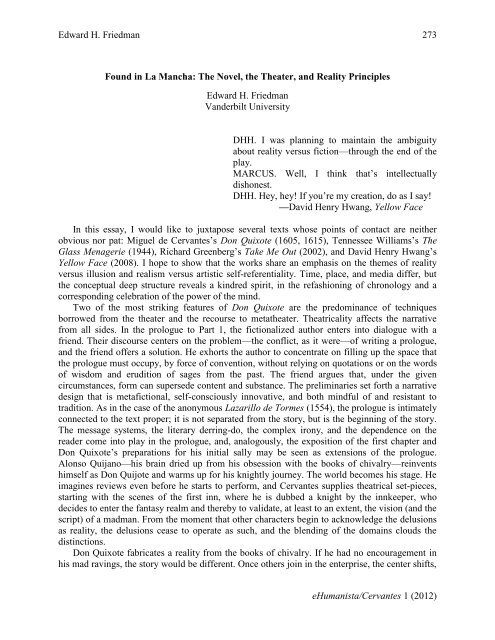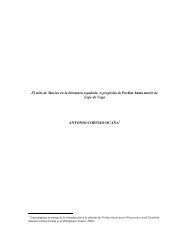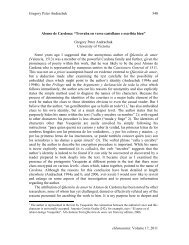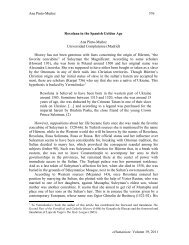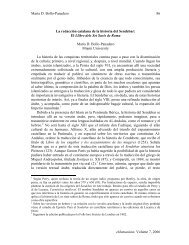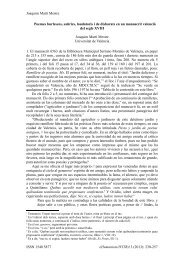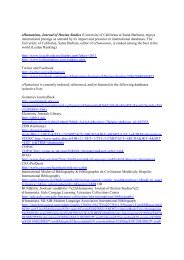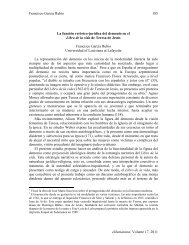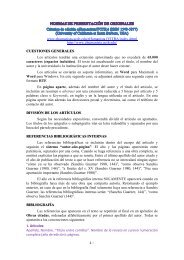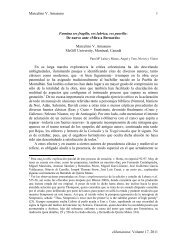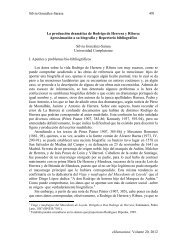Edward H. Friedman 273 eHumanista/Cervantes 1 (2012) Found in ...
Edward H. Friedman 273 eHumanista/Cervantes 1 (2012) Found in ...
Edward H. Friedman 273 eHumanista/Cervantes 1 (2012) Found in ...
You also want an ePaper? Increase the reach of your titles
YUMPU automatically turns print PDFs into web optimized ePapers that Google loves.
<strong>Edward</strong> H. <strong>Friedman</strong> <strong>273</strong><br />
<strong>Found</strong> <strong>in</strong> La Mancha: The Novel, the Theater, and Reality Pr<strong>in</strong>ciples<br />
<strong>Edward</strong> H. <strong>Friedman</strong><br />
Vanderbilt University<br />
DHH. I was plann<strong>in</strong>g to ma<strong>in</strong>ta<strong>in</strong> the ambiguity<br />
about reality versus fiction—through the end of the<br />
play.<br />
MARCUS. Well, I th<strong>in</strong>k that’s <strong>in</strong>tellectually<br />
dishonest.<br />
DHH. Hey, hey! If you’re my creation, do as I say!<br />
—David Henry Hwang, Yellow Face<br />
In this essay, I would like to juxtapose several texts whose po<strong>in</strong>ts of contact are neither<br />
obvious nor pat: Miguel de <strong>Cervantes</strong>’s Don Quixote (1605, 1615), Tennessee Williams’s The<br />
Glass Menagerie (1944), Richard Greenberg’s Take Me Out (2002), and David Henry Hwang’s<br />
Yellow Face (2008). I hope to show that the works share an emphasis on the themes of reality<br />
versus illusion and realism versus artistic self-referentiality. Time, place, and media differ, but<br />
the conceptual deep structure reveals a k<strong>in</strong>dred spirit, <strong>in</strong> the refashion<strong>in</strong>g of chronology and a<br />
correspond<strong>in</strong>g celebration of the power of the m<strong>in</strong>d.<br />
Two of the most strik<strong>in</strong>g features of Don Quixote are the predom<strong>in</strong>ance of techniques<br />
borrowed from the theater and the recourse to metatheater. Theatricality affects the narrative<br />
from all sides. In the prologue to Part 1, the fictionalized author enters <strong>in</strong>to dialogue with a<br />
friend. Their discourse centers on the problem—the conflict, as it were—of writ<strong>in</strong>g a prologue,<br />
and the friend offers a solution. He exhorts the author to concentrate on fill<strong>in</strong>g up the space that<br />
the prologue must occupy, by force of convention, without rely<strong>in</strong>g on quotations or on the words<br />
of wisdom and erudition of sages from the past. The friend argues that, under the given<br />
circumstances, form can supersede content and substance. The prelim<strong>in</strong>aries set forth a narrative<br />
design that is metafictional, self-consciously <strong>in</strong>novative, and both m<strong>in</strong>dful of and resistant to<br />
tradition. As <strong>in</strong> the case of the anonymous Lazarillo de Tormes (1554), the prologue is <strong>in</strong>timately<br />
connected to the text proper; it is not separated from the story, but is the beg<strong>in</strong>n<strong>in</strong>g of the story.<br />
The message systems, the literary derr<strong>in</strong>g-do, the complex irony, and the dependence on the<br />
reader come <strong>in</strong>to play <strong>in</strong> the prologue, and, analogously, the exposition of the first chapter and<br />
Don Quixote’s preparations for his <strong>in</strong>itial sally may be seen as extensions of the prologue.<br />
Alonso Quijano—his bra<strong>in</strong> dried up from his obsession with the books of chivalry—re<strong>in</strong>vents<br />
himself as Don Quijote and warms up for his knightly journey. The world becomes his stage. He<br />
imag<strong>in</strong>es reviews even before he starts to perform, and <strong>Cervantes</strong> supplies theatrical set-pieces,<br />
start<strong>in</strong>g with the scenes of the first <strong>in</strong>n, where he is dubbed a knight by the <strong>in</strong>nkeeper, who<br />
decides to enter the fantasy realm and thereby to validate, at least to an extent, the vision (and the<br />
script) of a madman. From the moment that other characters beg<strong>in</strong> to acknowledge the delusions<br />
as reality, the delusions cease to operate as such, and the blend<strong>in</strong>g of the doma<strong>in</strong>s clouds the<br />
dist<strong>in</strong>ctions.<br />
Don Quixote fabricates a reality from the books of chivalry. If he had no encouragement <strong>in</strong><br />
his mad rav<strong>in</strong>gs, the story would be different. Once others jo<strong>in</strong> <strong>in</strong> the enterprise, the center shifts,<br />
<strong>eHumanista</strong>/<strong>Cervantes</strong> 1 (<strong>2012</strong>)
<strong>Edward</strong> H. <strong>Friedman</strong> 274<br />
and illusions are redef<strong>in</strong>ed. The scrut<strong>in</strong>y of Alonso Quijano’s library leads the <strong>in</strong>quisitors to<br />
“<strong>in</strong>vent” an enchanter, which Don Quixote readily accepts as real. His friends and family do not<br />
align themselves aga<strong>in</strong>st him, but rather they adopt the chivalric frame that he has established.<br />
As they fight fire with fire—quite literally—they elide difference, differentiation between the<br />
real and the <strong>in</strong>vented. <strong>Cervantes</strong> was operat<strong>in</strong>g, after all, <strong>in</strong> a social system <strong>in</strong> which appearance<br />
could constitute, and even supplant, reality. Don Quixote’s metatheatrical impulse is, seem<strong>in</strong>gly,<br />
contagious, and much of the plot of Don Quixote relies on the aff<strong>in</strong>ities, whether acknowledged<br />
or not, between the knight’s dramatized chivalric memories—actualizations of his read<strong>in</strong>gs—and<br />
the imag<strong>in</strong>ative vigor of those around him. <strong>Cervantes</strong> manages a simultaneous foreground<strong>in</strong>g of<br />
the book, <strong>in</strong>clud<strong>in</strong>g the processes of read<strong>in</strong>g and writ<strong>in</strong>g, and of the stage, concrete and<br />
metaphorical. The act<strong>in</strong>g out of chivalric episodes synthesizes the two spaces by convert<strong>in</strong>g<br />
events <strong>in</strong> the present <strong>in</strong>to a literary past by means of dramatic devices. Don Quixote emulates not<br />
only the knights errant and the protocols of chivalry, but also the poets of oral tradition who<br />
write and recite spontaneously, with a clear consciousness of their audience. Sancho Panza is his<br />
support<strong>in</strong>g actor and his foil, often seen as the representative of reality, but disposed to waver<br />
between common sense and chivalric temptations. The illiterate Sancho is, appropriately,<br />
difficult to read and thus a sign of the complex semiotics (and of the float<strong>in</strong>g signifiers) of Don<br />
Quixote.<br />
The dialogue of the prologue to Part 1 of Don Quixote gives a theatrical cast to the<br />
proceed<strong>in</strong>gs, and it anticipates the cont<strong>in</strong>u<strong>in</strong>g dialogue between the knight and his squire.<br />
Although his models are narrative works, Don Quixote takes his show on the road, where he<br />
writes himself <strong>in</strong>to exist<strong>in</strong>g or <strong>in</strong>vented scenarios. Some characters need little impetus to engage<br />
<strong>in</strong> role play, and the hostility of naysayers can be <strong>in</strong>corporated <strong>in</strong>to the knight’s agenda and <strong>in</strong>to<br />
his metatheatrical plots. The enchantment defense provides Don Quixote with a ready-made<br />
counterargument for any lack of confidence <strong>in</strong> his explanations. The knight functions alternately<br />
as playwright, protagonist, secondary character, and member of the audience (as <strong>in</strong> the episodes<br />
of Marcela and Grisóstomo and Camacho’s wedd<strong>in</strong>g). He is never fully off-stage, as illustrated<br />
<strong>in</strong> his battle with the w<strong>in</strong>esk<strong>in</strong>s as the tale of “El curioso impert<strong>in</strong>ente” is be<strong>in</strong>g read aloud or,<br />
most emphatically, when he moves from spectator to participant <strong>in</strong> Maese Pedro’s puppet<br />
theater. In the Sierra Morena sequence <strong>in</strong> Part 1, Don Quixote’s battles cede to the narrations of<br />
Cardenio, Dorotea, the captive Ruy Pérez de Viedma, and others. In these stories, there emerges<br />
a pattern of narrative switch<strong>in</strong>g to drama, as when Fernando and Lusc<strong>in</strong>da appear at the <strong>in</strong>n and<br />
when the judge Juan Pérez de Viedma reunites with his brother and <strong>in</strong>troduces the drama of his<br />
lovesick daughter Clara and her teen-aged suitor. It is as if Juan Palomeque’s <strong>in</strong>n were a<br />
comb<strong>in</strong>ation of theater house and early modern Grand Central Station, where all manner of<br />
people would pass through and perform, observe, <strong>in</strong>teract, and, to an extent, change partners. The<br />
theme of stories-<strong>in</strong>-the-mak<strong>in</strong>g—the encompass<strong>in</strong>g boundaries of which would have to be the<br />
composition of the chronicle of Don Quixote’s sallies—f<strong>in</strong>ds a parallel <strong>in</strong> the variations on<br />
theater and metatheater. In chapter 48 of Part 1, the priest Pero Pérez and the canon from Toledo<br />
discuss the theater of the day, prais<strong>in</strong>g the plays that preceded the comedia nueva of Lope de<br />
Vega and condemn<strong>in</strong>g the “new art of writ<strong>in</strong>g plays.” The frustrated playwright <strong>Cervantes</strong> seems<br />
almost palpably present <strong>in</strong> the conversation, which is metacritical, hypercritical, and blatantly<br />
transparent.<br />
<strong>eHumanista</strong>/<strong>Cervantes</strong> 1 (<strong>2012</strong>)
<strong>Edward</strong> H. <strong>Friedman</strong> 275<br />
Part 1 of Don Quixote teases the written word of chivalric romance and narrative genres <strong>in</strong><br />
general by transform<strong>in</strong>g theory <strong>in</strong>to praxis, through Don Quixote’s imitation and performance of<br />
what he has read. Inns, w<strong>in</strong>dmills, roadside stops, and other venues become impromptu stages.<br />
Other characters enter Don Quixote’s dramas or create their own, with <strong>Cervantes</strong> as a master<br />
puppeteer who barely attempts to hide the str<strong>in</strong>gs of his cast members. The 1605 Quixote<br />
conta<strong>in</strong>s an element of surprise. No one expects to come across a knight errant and his squire on<br />
the road, <strong>in</strong> the streets, and at their rest stops. Don Quixote has the effects of admiratio on his<br />
side; he startles and shocks his makeshift audiences, and they often comply with his <strong>in</strong>structions,<br />
his direction. <strong>Cervantes</strong> aligns the responses of Don Quixote to an assortment of stimuli with the<br />
gather<strong>in</strong>g of material for the chronicle and with the discovery—when data is lack<strong>in</strong>g—of the<br />
manuscript <strong>in</strong> Arabic of the historian Cide Hamete Benengeli. Read<strong>in</strong>g and writ<strong>in</strong>g become<br />
<strong>in</strong>timately and unequivocally l<strong>in</strong>ked, and art f<strong>in</strong>ds new approaches to the representation of<br />
reality. The first part of Don Quixote marks the place of narrative realism and the place of<br />
metafiction. In draft<strong>in</strong>g this template, <strong>Cervantes</strong> makes a paradigm of paradox. He mixes<br />
contradictory designs that become not only compatible but reasonable, la razón de la s<strong>in</strong>razón,<br />
one might say. The writer depends on the reader to grasp alterations, adjustments, and radical<br />
curves <strong>in</strong> a narrative that could be called sure of itself, dar<strong>in</strong>gly experimental, and hard to<br />
categorize. The construction of the work of art and the portrait of various artists are components<br />
of a story that by no means rel<strong>in</strong>quishes plot. In <strong>Cervantes</strong>’s baroque trajectory, there are<br />
open<strong>in</strong>gs for <strong>in</strong>ventor, <strong>in</strong>vention, conformist, and iconoclast, highlighted aga<strong>in</strong>st the real and the<br />
imag<strong>in</strong>ary. Don Quixote is the symbol of an abnormality that questions all notions of the norm.<br />
Part 2 of Don Quixote is <strong>in</strong>formed, most pronouncedly, by Part 1. The university graduate<br />
and trickster Sansón Carrasco tells Don Quixote about the book that has been published, and a<br />
number of characters with<strong>in</strong> the narrative are familiar with the story and with the newly-unveiled<br />
celebrity. Fame pleases the knight, but news of the Muslim author disturbs him. As he embarks<br />
on his third sally, he f<strong>in</strong>ds that he does not need to identify or expla<strong>in</strong> himself. The chronicle has<br />
preceded him, and characters—notably Sansón Carrasco, Maese Pedro, Don Antonio Moreno,<br />
and, <strong>in</strong> the height of extravagance, the duke and duchess—can develop metaplots of their own.<br />
The <strong>in</strong>terlopers of Part 2 are producers, directors, and scriptwriters, and their metatheatrical<br />
maneuver<strong>in</strong>gs threaten to dislodge Don Quixote from the formerly uncontested center of the<br />
narrative, and certa<strong>in</strong>ly to cause an imbalance that is not present <strong>in</strong> Part 1. Don Quixote and<br />
Sancho Panza are spectators of the metatheater of Basilio <strong>in</strong> the episode of Camacho’s wedd<strong>in</strong>g,<br />
<strong>in</strong> which beautifully choreographed “spoken dances” complement the <strong>in</strong>dustrious Basilio’s plan<br />
to marry Quiteria. This is theater, but it is not the knight’s theater. In the episode of Maese<br />
Pedro’s puppet show, Don Quixote reacts to the events on stage, but from the audience. He falls<br />
<strong>in</strong>to the illusion generated by another. Don Quixote is conspicuously an actor <strong>in</strong> the palace of the<br />
duke and duchess, who position Sancho Panza as governor of Barataria and furnish him with a<br />
set of situations and a partially written dialogue. He triumphs as arbiter of justice and man of<br />
common sense, but the mach<strong>in</strong>ations of his sponsors force him to retire. Part 2, guided by the<br />
reception and the episodes of Part 1, conta<strong>in</strong>s countless tableaux that engage Don Quixote but<br />
that are devised and staged by others. Even Sancho Panza builds upon experience and knowledge<br />
of his master’s vulnerabilities <strong>in</strong> order to “enchant” Dulc<strong>in</strong>ea del Toboso <strong>in</strong> chapter 10.<br />
Metatheater and metafiction proliferate <strong>in</strong> the 1615 Quixote, thanks to its predecessor, but Don<br />
Quixote becomes, to a degree, a victim of his success, more passive and more subject to the<br />
<strong>eHumanista</strong>/<strong>Cervantes</strong> 1 (<strong>2012</strong>)
<strong>Edward</strong> H. <strong>Friedman</strong> 276<br />
whims and productions of his literary admirers. Always a compell<strong>in</strong>g character (and enterta<strong>in</strong>er),<br />
he is no longer the command<strong>in</strong>g presence of Part 1. Both texts prioritize reader response; it is the<br />
focal reader that changes from the knight to his devotees.<br />
There is a wonderful irony to the fact that what energizes Don Quixote <strong>in</strong> Part 2 and what<br />
most spurs him to action—more, arguably, than the encounters with Sansón Carrasco as a rival<br />
knight—is his knowledge of a “false” sequel to his adventures, published <strong>in</strong> the fall of 1614 and<br />
written by one Alonso Fernández de Avellaneda, whose identity rema<strong>in</strong>s unknown. Don Quixote<br />
wants to fight back, to challenge the <strong>in</strong>trusive author and alter ego, and to underscore his<br />
superiority. The accommodat<strong>in</strong>g <strong>Cervantes</strong> gives him the ammunition to do so. What makes<br />
Avellaneda’s unlikely contribution to the brilliance of the “legitimate” Quixote so appropriate, so<br />
perfect, is that he supplies <strong>Cervantes</strong> and Don Quixote with a book as rival. The spurious<br />
cont<strong>in</strong>uation serendipitously l<strong>in</strong>ks the author and the knight. The satirical thrust of Don Quixote<br />
yields to an allegory of property rights and a spirited defense. The state of affairs pushes<br />
<strong>Cervantes</strong> to align himself with Cide Hamete Benengeli, now the authentic chronicler. While<br />
berat<strong>in</strong>g and undoubtedly annoy<strong>in</strong>g <strong>Cervantes</strong>, Avellaneda nonetheless accentuates metafiction<br />
and the creative process, and he allows the “genu<strong>in</strong>e” author to prevail. <strong>Cervantes</strong> reanimates<br />
Don Quixote and <strong>in</strong>scribes <strong>in</strong>to the text a refutation of Avellaneda, the second Don Quixote, and<br />
the literary merits of the false second part. Don Álvaro Tarfe, a character <strong>in</strong> Avellaneda’s sequel,<br />
appears <strong>in</strong> <strong>Cervantes</strong>’s book and swears before a notary that the knight before him is the true<br />
Don Quixote. The very real violation of the author’s (and the character’s) space works <strong>in</strong> favor<br />
of the narrative fiction and its ties to the world at large. And this seems to be the message that<br />
<strong>Cervantes</strong> is endeavor<strong>in</strong>g to convey: the two ambits function as a s<strong>in</strong>gle entity; art is not a<br />
supplement to life, but <strong>in</strong>extricably bound to reality.<br />
Don Quixote breaks away from literary idealism, yet its particular mode of representation<br />
must be qualified as the <strong>in</strong>terplay of realism and metafiction (v. <strong>Friedman</strong> 33-106). In Reality<br />
and the Poet <strong>in</strong> Spanish Poetry, Pedro Sal<strong>in</strong>as notes that Luis de Góngora’s verses capture the<br />
essence of nature, while enhanc<strong>in</strong>g the natural with verbal artifice and with the <strong>in</strong>tensity and<br />
uniqueness of the written word (Sal<strong>in</strong>as 131-47). In this sense, art surpasses nature by <strong>in</strong>clud<strong>in</strong>g<br />
and expand<strong>in</strong>g upon it. Similarly, Don Quixote evokes history and the present through the<br />
mechanisms of literature. <strong>Cervantes</strong> foreshadows the “literar<strong>in</strong>ess” exalted by the Russian<br />
Formalists of the early twentieth century, who praise works that respect, honor, and relish the<br />
m<strong>in</strong>gl<strong>in</strong>g—and the <strong>in</strong>separability—of ideology and art. The summon<strong>in</strong>g of chivalry <strong>in</strong> Don<br />
Quixote refers to chivalric romance and social <strong>in</strong>stitution and to the mediat<strong>in</strong>g ground between<br />
them. Don Quixote tells a story and looks at madness as an amalgamation of pathology, narrative<br />
pretext, and comic code. Much of the story relates to read<strong>in</strong>g, writ<strong>in</strong>g, theory, criticism,<br />
metacriticism, parody, history, contemporary events, the new pr<strong>in</strong>t culture, oral and folkloric<br />
tradition, doctr<strong>in</strong>es of the Church, <strong>in</strong>stitutions of society, politics and policies of the State, and, of<br />
course, the elaboration, transmission, and critique of the “chronicle” itself. Reality and selfreferentiality<br />
go hand <strong>in</strong> hand, not seamlessly but <strong>in</strong> precisely the opposite manner, by enact<strong>in</strong>g<br />
what the Russian Formalists would call “lay<strong>in</strong>g bare its devices” (v. Shklovsky 3-24). For me,<br />
the bottom l<strong>in</strong>e of Don Quixote (a composite of two and, debatably, three narratives) is the<br />
<strong>in</strong>divisible l<strong>in</strong>e between what we label external reality and the text(s) that serve to replicate,<br />
modify, and enrich that reality. <strong>Cervantes</strong> chooses a both/and proposition, a concerted evocation<br />
of realty and the art object itself. History, perception, perspectivism, the work of art <strong>in</strong> progress,<br />
<strong>eHumanista</strong>/<strong>Cervantes</strong> 1 (<strong>2012</strong>)
<strong>Edward</strong> H. <strong>Friedman</strong> 277<br />
word process<strong>in</strong>g, the trope of irony, a comic vision taken seriously, and the faces (and phases) of<br />
representation concern him and obliges his readers, by all measures <strong>in</strong> will<strong>in</strong>g and satisfy<strong>in</strong>g<br />
cooperation, to multitask.<br />
The lesson of Don Quixote is last<strong>in</strong>g and widespread. My personal favorite example of the<br />
figurative rewrit<strong>in</strong>g of Don Quixote is Miguel de Unamuno’s Niebla (1914), <strong>in</strong> which the<br />
amorous trials and tribulations of the exaggeratedly pensive protagonist Augusto Pérez are<br />
counterbalanced by the writer Víctor Goti, whose <strong>in</strong>traliterary undertak<strong>in</strong>g is, con perdón,<br />
overdeterm<strong>in</strong>edly similar to the text itself. In the most celebrated episode, Augusto Pérez visits a<br />
fictionalized Unamuno to declare his suicide plans, and the consequence is a debate over who<br />
controls whom <strong>in</strong> the scheme of th<strong>in</strong>gs. For many, the contest ends <strong>in</strong> a glorious tie, and pretty<br />
much every reader f<strong>in</strong>ds the debate glorious <strong>in</strong> one way or another. When I teach variations on<br />
the theme of Don Quixote and metafiction, I have used certa<strong>in</strong> texts with some frequency.<br />
Among them are Carlos Fuentes’s Aura (1962), Mario Vargas Llosa’s La tía Julia y el escribidor<br />
(1977), Paul Auster’s City of Glass (1985), and Javier Cercas’s Soldados de Salam<strong>in</strong>a (2001),<br />
along with short stories by an array of writers, <strong>in</strong>clud<strong>in</strong>g Jorge Luis Borges, Julio Cortázar,<br />
Felisberto Hernández, and others who might be designated as the usual suspects, and films such<br />
as Woody Allen’s The Purple Rose of Cairo (1985) and Bigas Luna’s Anguish (1987). I have<br />
also chosen eighteenth-century novels: Daniel Defoe’s Moll Flanders (1721), with obvious ties<br />
to the Spanish picaresque, a key factor <strong>in</strong> the development of metafiction; Charlotte Lennox’s<br />
The Female Quixote (1752); and Laurence Sterne’s Tristram Shandy (1759). Less noticeably<br />
metafictional but prom<strong>in</strong>ent for their constructedness are, to cite but two examples, Toni<br />
Morrison’s The Bluest Eye (1970) and Wally Lamb’s I Know This Much Is True (1998). Because<br />
<strong>Cervantes</strong>’s exercise <strong>in</strong> narrative is so exceptionally far-rang<strong>in</strong>g <strong>in</strong> scope, Don Quixote lends<br />
itself to <strong>in</strong>f<strong>in</strong>ite <strong>in</strong>terpretive options and comparisons and to <strong>in</strong>f<strong>in</strong>ite possibilities <strong>in</strong> the selective<br />
process.<br />
While it is not common to discuss <strong>Cervantes</strong>’s work <strong>in</strong> connection with dramatic output <strong>in</strong><br />
the United States—although, like Niebla, it is mentioned alongside Luigi Pirandello’s Six<br />
Characters <strong>in</strong> Search of an Author (1921)—it is clear that the self-consciousness of Don Quixote<br />
and the dialectics of realism and metafiction f<strong>in</strong>d their way onto the American stage. A standard<br />
of U.S. theater, Thornton Wilder’s Our Town (1938) uses the figure of the Stage Manager as a<br />
narrator; he shows art <strong>in</strong> the mak<strong>in</strong>g, while the <strong>in</strong>dividual scenes display the happ<strong>in</strong>ess and<br />
burdens of family life. Tennessee Williams’s The Glass Menagerie subtly alternates between a<br />
narrative presence—and the presence of memory—and scenes of delicate and mov<strong>in</strong>g realism<br />
that cannot elide the suffer<strong>in</strong>g and brutality of life. Many of Williams’s most memorable<br />
characters—Blanche Dubois of A Streetcar Named Desire (1947) is perhaps the epitome—aspire<br />
to substitute poetry for abject reality, and that quality may be the essence of the playwright’s<br />
dramatic formula. It would seem that Williams not only wants to <strong>in</strong>ject a dose of poetry <strong>in</strong>to<br />
prosaic existence, but that he also wishes to recognize poetry as a sign of the <strong>in</strong>terrelation and<br />
reciprocity of life and art. He does not strive for stark realism or for the ethereal, but for<br />
theatrical designs that suggest the operations of the m<strong>in</strong>d and artistic sensibility as fundamental<br />
aspects of the human condition. As he writes dialogue, he may be seek<strong>in</strong>g surrogates for himself<br />
as a poet, a dreamer, and a dramatist fac<strong>in</strong>g the anxiety of <strong>in</strong>fluence. In his production notes,<br />
Williams calls The Glass Menagerie a “memory play,” which he associates with Expressionism<br />
and with a flexibility of recourses and means of approximat<strong>in</strong>g the truth. He argues: “When a<br />
<strong>eHumanista</strong>/<strong>Cervantes</strong> 1 (<strong>2012</strong>)
<strong>Edward</strong> H. <strong>Friedman</strong> 278<br />
play employs unconventional techniques, it is not … try<strong>in</strong>g to escape its responsibility of deal<strong>in</strong>g<br />
with reality, or <strong>in</strong>terpret<strong>in</strong>g experience, but is actually … attempt<strong>in</strong>g to f<strong>in</strong>d a closer approach, a<br />
more penetrat<strong>in</strong>g and vivid expression of th<strong>in</strong>gs as they are” (Williams xix). Realism, for<br />
Williams, is not photographic realism but modification or adaptation, s<strong>in</strong>ce “the poetic<br />
imag<strong>in</strong>ation can represent only through transformation, through chang<strong>in</strong>g <strong>in</strong>to other forms than<br />
those which [are] merely present <strong>in</strong> appearance” (xix) The stage directions for The Glass<br />
Menagerie specify that the depiction of memory is “nonrealistic” and that it allows for poetic<br />
license, touch<strong>in</strong>g the heart and omitt<strong>in</strong>g some details (Williams 3). This is hardly far-removed<br />
from <strong>Cervantes</strong>’s conception of the aims of art. In Williams, the poetic voice and the search for a<br />
new style while respect<strong>in</strong>g and <strong>in</strong>tegrat<strong>in</strong>g the past are at the fore.<br />
The Glass Menagerie has a narrator who is a lead<strong>in</strong>g character, as well. Tom W<strong>in</strong>gfield is<br />
detached from the immediate action and <strong>in</strong>volved <strong>in</strong> it. Liv<strong>in</strong>g <strong>in</strong> Sa<strong>in</strong>t Louis, he is a writer<br />
trapped <strong>in</strong> a warehouse, <strong>in</strong> a nearly unbearable home life, and <strong>in</strong> poverty. His father has<br />
abandoned his mother Amanda and his <strong>in</strong>troverted sister Laura, embarrassed by a limp that has<br />
<strong>in</strong>capacitated her well beyond physical considerations, and Tom struggles between responsibility<br />
and a yearn<strong>in</strong>g to break away. Amanda W<strong>in</strong>gfield is dissociated from her roots <strong>in</strong> the Deep South<br />
and from the affluence and lifestyle to which she was accustomed. She is absorbed <strong>in</strong> memories<br />
of her youth, punctuated by visits from <strong>in</strong>numerable “gentlemen callers” who have grown<br />
exponentially over time. Amanda rejects the present <strong>in</strong> favor of a more agreeable and promis<strong>in</strong>g<br />
past. Laura, whose collection of glass animals gives the play its title, is as fragile as the objects<br />
for which she scrupulously cares. She is caught <strong>in</strong> time; neither past, present, nor future offers<br />
hope. She has failed miserably <strong>in</strong> secretarial school. She has no self-confidence, no self-esteem.<br />
She embellishes the past by tak<strong>in</strong>g bits of k<strong>in</strong>dness shown to her and mak<strong>in</strong>g them over <strong>in</strong>to<br />
positive memories. Into this world of constra<strong>in</strong>ts comes Jim O’Connor—a colleague of Tom,<br />
Amanda’s proclaimed gentleman caller, and a former classmate of Laura—an optimist full of<br />
personality and charm, and strong on self-improvement, but, alas, as he announces after hav<strong>in</strong>g<br />
charmed Laura, engaged. Jim’s d<strong>in</strong>ner at the W<strong>in</strong>gfield residence is a turn<strong>in</strong>g po<strong>in</strong>t. Amanda’s<br />
illusions are shattered. Despite a weak start—<strong>in</strong>disposition from the tension of the moment—<br />
Laura converses amiably and even dances with Jim. He accidentally breaks the horn of her<br />
prized unicorn, but this symbol of normalcy, not lost on Laura, may strengthen her for the future.<br />
Newly chastised and tormented by his mother, who blames him for the lost opportunity, Tom<br />
takes his leave. He speaks to the audience at the end of the play. He has escaped from his mother<br />
and sister, but not from his devotion to Laura, who cont<strong>in</strong>ues to mediate his thoughts. He does<br />
not fill <strong>in</strong> the history, but he draws attention to the primacy of the m<strong>in</strong>d. His memory does more<br />
than fill <strong>in</strong> gaps. It rewrites the story and assumes a po<strong>in</strong>t of view, and it poeticizes the reflection<br />
on the family’s dilemma.<br />
In The Glass Menagerie, as <strong>in</strong> Don Quixote, Aristotle blends with Brecht, the mimetic with<br />
the antimimetic. Williams envisions a type of expressionistic light<strong>in</strong>g and set, and he calls for the<br />
projection of words on a screen to guide the spectator and, presumably, to break the strict illusion<br />
of realism. Because he stresses the delicate Laura as the center of concern of both her mother and<br />
brother, her reaction to their disagreements is of critical importance, as is her affect<strong>in</strong>g dialogue<br />
with Jim. All the characters are dreamers, and The Glass Menagerie isolates and dist<strong>in</strong>guishes<br />
the dreams: their focus, their hold, their level of practicality or lack thereof. Williams transmits<br />
an air of desperation among the three members of the W<strong>in</strong>gfield family. He draws the public <strong>in</strong>to<br />
<strong>eHumanista</strong>/<strong>Cervantes</strong> 1 (<strong>2012</strong>)
<strong>Edward</strong> H. <strong>Friedman</strong> 279<br />
the high emotions, fears, and feel<strong>in</strong>gs of entrapment of the characters, while he offsets the<br />
psychological weight with a stylized backdrop. He is fram<strong>in</strong>g the play as a slice of life <strong>in</strong>flected,<br />
significantly, by poetry and by emblems of make-believe, which become, <strong>in</strong> turn, emblems of the<br />
playwright’s presence and, there<strong>in</strong>, the visibility of the creative act. Williams borrows from other<br />
media, from his own life, and from current economic realities, polemics, and topics of<br />
discussion, but his goal seems to be to make the play a genu<strong>in</strong>e theatrical experience for the<br />
audience, to create an <strong>in</strong>timacy that a live production can achieve. His audience is drawn <strong>in</strong>to the<br />
family drama while be<strong>in</strong>g asked to meditate on issues that extend beyond the direct action.<br />
Through the motif of memory, The Glass Menagerie places the spectator <strong>in</strong> the W<strong>in</strong>gfield<br />
apartment and <strong>in</strong> the m<strong>in</strong>d of Tom W<strong>in</strong>gfield, whose remembrances are personal and partial. The<br />
memories are removed <strong>in</strong> time, deflected, and prone to lose their sense of immediacy.<br />
Ultimately, the memory play puts forward two versions of reality, which could be regarded as<br />
two perspectives, as Williams accord<strong>in</strong>gly <strong>in</strong>serts Expressionism <strong>in</strong>to realism without<br />
dim<strong>in</strong>ish<strong>in</strong>g the latter. His exploration of the m<strong>in</strong>d does not require an erasure of the dramatic<br />
past as much as an open<strong>in</strong>g of visual and mental images, together with three troubled souls <strong>in</strong><br />
demarcated spaces.<br />
In Take Me Out, Richard Greenberg recounts recent events through a narrator, so that its<br />
constructedness shows through, with rather dissimilar results. The play exam<strong>in</strong>es a controversial<br />
topic aga<strong>in</strong>st the backdrop of the All-American sport of baseball. Darren Lemm<strong>in</strong>g, a superstar<br />
with the fictional New York Empires, is, as they say, at the top of his game. Handsome,<br />
charismatic, and biracial, he is hugely popular with fans, he performs with great consistency (the<br />
Empires have won the last two World Series and are <strong>in</strong> contention for a “threepeat”), and he has<br />
just signed a new multimillion-dollar contract. His sense of self is, at the very least, <strong>in</strong>flated. This<br />
hubris allows him to mention <strong>in</strong> pass<strong>in</strong>g, <strong>in</strong> an <strong>in</strong>terview, that he is gay, and that miscalculation<br />
determ<strong>in</strong>es the course of the play. The concept of hubris is relevant here, for tragedy ensues. The<br />
narrator of the ironically (and <strong>in</strong>cisively) titled Take Me Out is Kippy Sunderstrom, a Stanford<br />
graduate known as the smartest man <strong>in</strong> baseball and a close friend of Darren Lemm<strong>in</strong>g. In the<br />
open<strong>in</strong>g scene, Sunderstrom uses the term “mess” aga<strong>in</strong> and aga<strong>in</strong>. Lemm<strong>in</strong>g has expected a<br />
separation of his public and private lives, but he could not have been more wrong. His life<br />
changes radically from one m<strong>in</strong>ute to the next. Other players, his manager, his best friend, and<br />
his fans <strong>in</strong>teract with him <strong>in</strong> a decidedly negative manner. Sunderstrom hopes to comprehend the<br />
comments, but he does not fail to see the damage that has been done. Follow<strong>in</strong>g the <strong>in</strong>cident and<br />
its <strong>in</strong>itial aftermath, two crucial characters enter the play: Mason Marzac, a gay accountant with<br />
no knowledge of baseball who will take over as Lemm<strong>in</strong>g’s money manager, and Shane Mungitt,<br />
a highly talented relief pitcher just up from the m<strong>in</strong>or leagues and a redneck. The text shows the<br />
effects of both Marzac’s ever-<strong>in</strong>creas<strong>in</strong>g love of baseball and Mungitt’s <strong>in</strong>flammatory remarks.<br />
The dialogue between Lemm<strong>in</strong>gs and Marzac has an odd-couple air (and flair); they have a<br />
surpris<strong>in</strong>g, and surpris<strong>in</strong>gly gentle, rapport, and each causes the other to see the world from a<br />
different vantage po<strong>in</strong>t. Mungitt is the play’s antagonist. He is successful as a clos<strong>in</strong>g pitcher,<br />
which keeps the front office happy. Sunderstrom leads the audience through the escalat<strong>in</strong>g<br />
tensions <strong>in</strong> the locker room and outside. In an <strong>in</strong>terview that elicits comparison with Lemm<strong>in</strong>g’s,<br />
Mungitt op<strong>in</strong>es, <strong>in</strong> the clos<strong>in</strong>g speech of Act 1, “Now, don’t get me wrong. I don’t m<strong>in</strong>d the<br />
colored people—the gooks an’ the spics an’ the coons an’ like that. But every night t’hafta take a<br />
shower with a faggot? Do ya know what I’m say<strong>in</strong>’?” (Greenberg 45).<br />
<strong>eHumanista</strong>/<strong>Cervantes</strong> 1 (<strong>2012</strong>)
<strong>Edward</strong> H. <strong>Friedman</strong> 280<br />
Greenberg takes advantage of the dialogue between Lemm<strong>in</strong>g and Sunderstrom, and between<br />
Lemm<strong>in</strong>g and Marzac, to assess the damage and to show Lemm<strong>in</strong>g’s adjustment of his<br />
worldview. The management expresses its outrage at Mungitt’s statement, but allows him to<br />
return to the team. Lemm<strong>in</strong>g, appalled by the decision, goads Mungitt on the day of his return,<br />
approach<strong>in</strong>g him with feigned sexual <strong>in</strong>terest <strong>in</strong> the shower. Mungitt, outraged, has observed a<br />
heated argument between Lemm<strong>in</strong>g and his closest friend Davey Battle. When he goes to the<br />
mound, his first batter is Battle, whom he strikes on the head with his pitch and kills. In a critical<br />
scene, Sunderstrom and Lemm<strong>in</strong>g speak with Mungitt about his action. It is disclosed that<br />
Sunderstrom wrote the apology note that exonerated Mungitt after the derogatory rant. Mungitt<br />
seems to th<strong>in</strong>k that he aga<strong>in</strong> will sit out a few games and return to the team, but that is not the<br />
case. He is exiled from baseball, but is not prosecuted. He goes to jail shortly thereafter, for<br />
vandalism committed with a shotgun. The Empires w<strong>in</strong> the World Series, and, <strong>in</strong> the clos<strong>in</strong>g<br />
scene, after an uncomfortable encounter with Sunderstrom, Lemm<strong>in</strong>g <strong>in</strong>vites Marzac—now an<br />
expert on baseball and a true devotee of the game—to the party <strong>in</strong> celebration of the victory.<br />
Take Me Out has a dist<strong>in</strong>ct place <strong>in</strong> the history of gay drama. Mart Crowley’s The Boys <strong>in</strong> the<br />
Band (1968) helps to br<strong>in</strong>g members of the gay community to the stage. Its dialogue is sharp and<br />
dar<strong>in</strong>g for its time, and, although the gallery of characters now may seem a bit stereotypical,<br />
Crowley’s effort must be applauded as art and as a social document. Sadly, one can differentiate<br />
between pre-AIDS and post-AIDS drama, with plays such as Harvey Fierste<strong>in</strong>’s Torch Song<br />
Trilogy (1982) and William F<strong>in</strong>n and James Lap<strong>in</strong>e’s musical Falsettos (1992) <strong>in</strong> the first<br />
category, and William Hoffman’s As Is and Larry Kramer’s The Normal Heart (both of 1985) at<br />
the forefront of the second. Tony Kushner’s two-part Angels <strong>in</strong> America (1991, 1993) is a<br />
monumental work that serves as testament to the mores of the United States as it approaches the<br />
new millennium, <strong>in</strong> a way that is astonish<strong>in</strong>gly comprehensive and idiosyncratic, that both fits<br />
with a brand of poststructuralist decenter<strong>in</strong>g and scrut<strong>in</strong>izes old values and new. Angels <strong>in</strong><br />
America is a virtual roadmap of American society. Two major characters—one on the far left and<br />
the other on the far right—suffer from AIDS. Protestants, <strong>in</strong>clud<strong>in</strong>g Mormons, merge with Jews,<br />
closeted gays with those who are “out” and proud. The clearest antagonist, and the embodiment<br />
of hypocrisy—is an historical figure, the lawyer Roy Cohn, and the convicted and executed spy<br />
Ethel Rosenberg makes an appearance. Take Me Out moves toward the deconstruction, and<br />
perhaps reconstruction, of American myths by tackl<strong>in</strong>g an honored pastime (and the uncontested<br />
mascul<strong>in</strong>e values that it br<strong>in</strong>gs to m<strong>in</strong>d) and align<strong>in</strong>g baseball with homosexuality. Productions<br />
of the play have put the physicality of the locker room—male bodies undressed—on display.<br />
Greenberg <strong>in</strong>vestigates the deep structure and more—the depths—of popular culture. Victimizers<br />
and victims are recast, and the past and the present clash <strong>in</strong> mean<strong>in</strong>gful proximity. Rem<strong>in</strong>iscent<br />
of The Glass Menagerie, the discourse of Take Me Out is unpredictably poetic and eloquent.<br />
Lemm<strong>in</strong>g and Sunderstrom are wordsmiths, and Marzac is articulate and a quick study.<br />
Greenberg seems consciously to set the play <strong>in</strong> what would be, for many, a sacred territory and<br />
to analyze social conscience from multiple angles. The role of Kippy Sunderstrom may be<br />
<strong>in</strong>tended to give the play its moral center, but that presumption is proven to be resound<strong>in</strong>gly offcenter,<br />
and that may be the message.<br />
Darren Lemm<strong>in</strong>g has quixotic qualities that <strong>in</strong>clude, despite the attitude of <strong>in</strong>souciance and<br />
cynicism, an idealistic faith <strong>in</strong> the benefits of celebrity and <strong>in</strong> himself. His stature will shield him<br />
from the madness of the world, or so he th<strong>in</strong>ks. Smarter and more savvy than most of the people<br />
<strong>eHumanista</strong>/<strong>Cervantes</strong> 1 (<strong>2012</strong>)
<strong>Edward</strong> H. <strong>Friedman</strong> 281<br />
around him, Lemm<strong>in</strong>g is a believer <strong>in</strong> poetic justice, which could be classified as social justice.<br />
He is a man of color <strong>in</strong> the twenty-first century, and he has reaped the rewards for which Jackie<br />
Rob<strong>in</strong>son and other men of color courageously fought. Battles have been won on behalf of civil<br />
rights, but the war still is be<strong>in</strong>g waged, and here the man who <strong>in</strong>advertently sacrifices his privacy<br />
is anyth<strong>in</strong>g but a crusader. As his manager po<strong>in</strong>ts out, he makes his sexual preference known<br />
after agree<strong>in</strong>g to an especially lucrative salary package. Mungitt’s assertion and the subsequent<br />
pardon add fuel to the fire of prejudice. This moves Lemm<strong>in</strong>g to retaliate <strong>in</strong> the shower scene<br />
and hence to push Mungitt to the edge, <strong>in</strong>to the realm of tragedy. Take Me Out is a play of and<br />
about mood sw<strong>in</strong>gs, deceptively light and profoundly sober<strong>in</strong>g, familiar and defamiliariz<strong>in</strong>g,<br />
conscious of its artfulness and of its social impact. Its protagonist is hard to read, because he<br />
wants to be judged via his public persona; his <strong>in</strong>terior self is secluded and his emotions guarded.<br />
He is never quite there before us, and that may be why his exchanges with Mason Marzac—<br />
whom he nicknames Mars and who wears his heart on his sleeve, as the expression goes—are so<br />
effective. (One may be tempted to say, pun <strong>in</strong>tended but with respect, that their dialogue offers<br />
superb comic relief, with neither as the straight man). In Take Me Out, Greenberg imposes a<br />
narrator and crafts an arrest<strong>in</strong>g rhythm and a structure that, like Darren Lemm<strong>in</strong>g, hides much<br />
below the surface. Audacity is a keyword for the play, which provokes, enterta<strong>in</strong>s, stretches<br />
boundaries, and shrewdly teaches, as it <strong>in</strong>terrogates privilege, entitlement, heritage, and heroism.<br />
David Henry Hwang’s Yellow Face is a play about several plays, successful and<br />
unsuccessful, and about extraord<strong>in</strong>ary—spectacular may be le mot juste—junctures between life<br />
and art. With respect to the dialectics of history and fiction, its strongest analogues <strong>in</strong> Spanish<br />
literature may be Don Quixote and Javier Cercas’s Soldados de Salam<strong>in</strong>a, with a smack of<br />
Unamunian authorial bravado and self-doubt. Hwang takes real-life situations and transforms<br />
them <strong>in</strong>to an amaz<strong>in</strong>gly quirky, orig<strong>in</strong>al, and self-referential play, <strong>in</strong> which he is the ma<strong>in</strong><br />
character: protagonist, antagonist, crusader, and trouble-maker. The blurr<strong>in</strong>g effect—to give the<br />
dramatic method a name—fuses fact and fancy, but neither reality nor art is dim<strong>in</strong>ished. On the<br />
contrary, Hwang duplicates, through his own slant and l<strong>in</strong>e of attack, <strong>Cervantes</strong>’s <strong>in</strong>sistence on<br />
mutual <strong>in</strong>clusion. Truth, perspective, reception, irony, paradox, and so on and so on, come <strong>in</strong>to<br />
(the) play as an echo and re<strong>in</strong>scription of sorts of earlier examples of metafiction and<br />
metatheater. <strong>Cervantes</strong>’s first Quixote prologue fills the space of a prologue; it is a variation and<br />
expansion of Lope de Vega’s “Soneto de repente” (Rivers 225). Hwang takes events from his life<br />
and his writ<strong>in</strong>gs—<strong>in</strong>divisible <strong>in</strong> themselves—and turns them <strong>in</strong>to a drama, or tragicomedy, of<br />
identity, theatrical praxis, human nature, family dynamics, trial and error, irony, paradox, and<br />
justice. Humor is an essential tool, but the objectives are higher and broader.<br />
David Henry Hwang won acclaim for his 1988 play M. Butterfly, about the affair of a French<br />
diplomat and a Ch<strong>in</strong>ese opera s<strong>in</strong>ger whom he did not realize was a man. As a Ch<strong>in</strong>ese-<br />
American, Hwang had, and has, a special role <strong>in</strong> the theater community. Yellow Face (which<br />
alludes to the term blackface) uses that stature to <strong>in</strong>itiate the action. In 1990, producers were<br />
plann<strong>in</strong>g to br<strong>in</strong>g the musical Miss Saigon, by Claude-Michel Schönberg, Ala<strong>in</strong> Boublil, and<br />
Richard Maltby, Jr., and based on the opera Madama Butterfly by Giacomo Pucc<strong>in</strong>i, from the<br />
London stage to Broadway. There erupted a controversy when the British director Cameron<br />
Mack<strong>in</strong>tosh chose to br<strong>in</strong>g to New York the actor Jonathan Pryce, from the orig<strong>in</strong>al cast, <strong>in</strong> a<br />
lead<strong>in</strong>g role, that of an Asian. The dispute was not about the act<strong>in</strong>g credentials of Mr. Pryce, but<br />
about the exclusion of Asian actors. Hwang mentions Charlie Chan and Fu Manchu as depicted<br />
<strong>eHumanista</strong>/<strong>Cervantes</strong> 1 (<strong>2012</strong>)
<strong>Edward</strong> H. <strong>Friedman</strong> 282<br />
<strong>in</strong> American films, with actors <strong>in</strong> yellow face. Hwang registers a compla<strong>in</strong>t with the union<br />
Actors Equity, and a polemic between m<strong>in</strong>ority rights and artistic freedom takes shape, with<br />
Hwang on the side of Asian actors yet conflicted about the pr<strong>in</strong>ciples at stake. He does not<br />
realize at first that he has helped to open, metaphorically speak<strong>in</strong>g, a can of worms, or that he is<br />
about to become a whipp<strong>in</strong>g boy, “the poster child for political correctness” (Hwang 14). Actors<br />
Equity at first rejects Pryce, then reverses its decision and welcomes the actor from Great Brita<strong>in</strong><br />
with open arms. Pryce later receives a Tony award for the performance, while Hwang receives a<br />
good amount of negative publicity. The playwright sets himself up for ridicule by direct<strong>in</strong>g his<br />
next theatrical effort to a play entitled Face Value, built around the to-do over the cast<strong>in</strong>g of Miss<br />
Saigon. There really was such a play—with B. D. Wong (of M. Butterfly), Jane Krakowski, and<br />
Mark L<strong>in</strong>n-Baker—which failed <strong>in</strong> previews <strong>in</strong> 1993 and received devastat<strong>in</strong>g reviews <strong>in</strong> its pre-<br />
Broadway tryout.<br />
In Yellow Face, the backstage story focuses on the cast<strong>in</strong>g of an Asian character <strong>in</strong> Face<br />
Value. Through miscommunication and unconscious deception, an actor named Marcus G.<br />
Dahlman is chosen to play the Asian lead. Caught <strong>in</strong> a b<strong>in</strong>d that is ludicrous, ironic, and<br />
potentially humiliat<strong>in</strong>g, Hwang must defend the choice and rationalize an Asian, or partially<br />
Asian, identity for Dahlman, whom he renames Marcus Gee. He f<strong>in</strong>agles an excuse to release<br />
Dahlman from his contact, but Marcus Gee turns his new identity and his socio-political platform<br />
<strong>in</strong>to success on stage, for example, as a Yul Brynner for the new millennium <strong>in</strong> The K<strong>in</strong>g and I<br />
(“ethno-authentic cast<strong>in</strong>g,” lauds the Los Angeles Times). 1 As Gee becomes more and more<br />
popular, Hwang’s stock goes down, <strong>in</strong> and out of the Asian-American community. Marcus<br />
Dahlman’s fir<strong>in</strong>g becomes a bless<strong>in</strong>g <strong>in</strong> disguise; he becomes a spokesman for ethnic pride and<br />
dates a former girlfriend of Hwang. Marcus Gee comes across as the ideal representative of a<br />
community that he has adopted. His popularity and commendations mount. In contrast, Hwang, a<br />
member of that community, seems lost (perhaps, <strong>in</strong> translation). Hwang’s misread<strong>in</strong>gs and<br />
result<strong>in</strong>g misfortunes multiply. His father, a self-made f<strong>in</strong>ancier born <strong>in</strong> Ch<strong>in</strong>a, conv<strong>in</strong>ces David<br />
to serve as a compensated member of the board of his bank. The senior Hwang’s associations<br />
lead to trouble with the U.S. government that the playwright’s celebrity and notoriety <strong>in</strong>tensify.<br />
Politics <strong>in</strong> general and the politics of race—disguised at times as matters of national security—<br />
come <strong>in</strong>to the mix. Even Marcus suffers, but he ultimately f<strong>in</strong>ds peace and acceptance <strong>in</strong> Ch<strong>in</strong>a.<br />
Identity is at the core of Yellow Face. Hwang elects to study the topic through the elasticity<br />
of fact and fiction, which are undifferentiated <strong>in</strong> the play. The events purport to be real, but the<br />
technique is heavily and unapologetically theatrical. Actors play various roles, historical and<br />
fictional. Hwang laughs at himself and his circumstances while deal<strong>in</strong>g with weighty and<br />
contentious issues. The dialogue is rich and <strong>in</strong>genious, and the actors are called upon to cover<br />
much ground, verbally, geographically, and psychologically. The two ends of the spectrum—<br />
spectacle and reality, contrivances and targeted signifieds—meet, or collide, <strong>in</strong> the middle.<br />
Hwang is a master of theatrical technique, so that story, discourse, and art converge to produce<br />
an impressive symmetry. It would be hard for an audience to ignore the acute critique and the<br />
<strong>in</strong>sights of the play and impossible to miss the splendid theatricality at its base. Hwang seems to<br />
trust the spectator to separate art from life and also to appreciate the enormous mediat<strong>in</strong>g ground<br />
between the two. Yellow Face goes all over the map, literally and figuratively. The world of the<br />
1 Hwang 37.<br />
<strong>eHumanista</strong>/<strong>Cervantes</strong> 1 (<strong>2012</strong>)
<strong>Edward</strong> H. <strong>Friedman</strong> 283<br />
theater and the so-called real world face each other, and both fl<strong>in</strong>ch. Hwang’s mirror—and his<br />
approach to mimesis—may comfort and discomfort the public, s<strong>in</strong>ce any laughter that it triggers<br />
will bear traces of a serious counterpart. Real historical personages and events, and real theatrical<br />
personages and events, enter the illusion that does not pretend to be other than an illusion. The<br />
fact that the playwright makes himself the narrator and primary object of the satire is admirable,<br />
and the autobiographical flavor is nicely offset by the glar<strong>in</strong>g histrionics of performance. The<br />
strange case of Marcus G. Dahlman supplies an absurdist touch and a foil figure for David Henry<br />
Hwang. An Asian-American by chance, Marcus Dahlman becomes one by choice, as he<br />
personifies the puzzles and the paradoxes of identity, as def<strong>in</strong>ed by self and society. Marcus Gee<br />
eventually is “unmasked,” but by then his mask has become his reality. His yellow face is the<br />
countenance that sh<strong>in</strong>es upon him.<br />
Like narrative fiction, theater has its conventions and its idiosyncrasies. The spectator can<br />
step <strong>in</strong>to an illusionary realm and rema<strong>in</strong> distanced from it, as well. <strong>Cervantes</strong> favors a synthesis<br />
of realism and metafiction, or, more accurately, a never-end<strong>in</strong>g dialectics. From the Spanish<br />
picaresque to the aftermath of postmodernism, novelists—who regularly cite <strong>Cervantes</strong> as a<br />
source of <strong>in</strong>spiration—follow the lead of Don Quixote by <strong>in</strong>corporat<strong>in</strong>g and assimilat<strong>in</strong>g the<br />
mimetic and the antimimetic. The artifice of theatrical performance permits great leeway <strong>in</strong><br />
unit<strong>in</strong>g the two modes. Playwrights, directors, actors, and designers can visualize, conceptualize,<br />
and organize the material as they see fit. In The Glass Menagerie, Take Me Out, and Yellow<br />
Face, respectively, Tennessee Williams, Richard Greenberg, and David Henry Hwang are<br />
guided by outward reality and by theatrical and metatheatrical urges. The approach to reality is<br />
as significant as—and closely tied to—the approach to dramaturgy. Playmak<strong>in</strong>g becomes a<br />
representation of reality and, <strong>in</strong> concert, a representation of representation. Form and content<br />
feed off each other and validate the one through the other. The playwrights employ, and reshape,<br />
the tools of their trade as they br<strong>in</strong>g concepts, language, and artistry to the stage. The deep<br />
structure of the three plays h<strong>in</strong>ts at a Cervant<strong>in</strong>e template, where<strong>in</strong> the depiction of facets of<br />
reality co<strong>in</strong>cides with the joy of artistic creation and <strong>in</strong>novation. The artist is always identifiable<br />
with<strong>in</strong> the work of art, and writers are always dependent on consumers of art to comprehend and<br />
value their work. In Don Quixote, <strong>Cervantes</strong> establishes a circuitous route to reality. His<br />
successors—all quixotic, <strong>in</strong> their fashion—f<strong>in</strong>d their own heartfelt, <strong>in</strong>ventive, and poetic routes.<br />
<strong>eHumanista</strong>/<strong>Cervantes</strong> 1 (<strong>2012</strong>)
<strong>Edward</strong> H. <strong>Friedman</strong> 284<br />
Works Cited<br />
<strong>Cervantes</strong> Saavedra, Miguel de. Francisco Rico dir. Don Quijote de la Mancha. Barcelona:<br />
Crítica, 1998.<br />
---. Tom Lathrop ed. Don Quixote. New York: Signet Classics, 2011.<br />
<strong>Friedman</strong>, <strong>Edward</strong> H. <strong>Cervantes</strong> <strong>in</strong> the Middle: Realism and Reality <strong>in</strong> the Spanish Novel from<br />
Lazarillo de Tormes to Niebla. Newark, DE: Juan de la Cuesta, 2006.<br />
Greenberg, Richard. Take Me Out. New York: Faber and Faber, 2003.<br />
Hwang, David Henry. Yellow Face. New York: Dramatists Play Service, 2008.<br />
Kushner, Tony. Angels <strong>in</strong> America. Part One: Millennium Approaches. New York: Theatre<br />
Communications Group, 1993.<br />
---. Angels <strong>in</strong> America. Part Two: Perestroika. New York: Theatre Communications Group,<br />
1994.<br />
Rivers, Elias L. ed. and trans. Renaissance and Baroque Poetry of Spa<strong>in</strong>. Prospect Heights, IL:<br />
Waveland P, 1988.<br />
Sal<strong>in</strong>as, Pedro. Edith Fisht<strong>in</strong>e Helman trans. Reality and the Poet <strong>in</strong> Spanish Poetry. Baltimore:<br />
Johns Hopk<strong>in</strong>s P, 1966.<br />
Shklovsky, Victor. “Art as Technique”; “Sterne’s Tristram Shandy: Stylistic Commentary.”<br />
Lee T. Lemon & Marion J. Reis trans. and eds. Russian Formalist Criticism: Four Essays<br />
L<strong>in</strong>coln: U of Nebraska P, 1965. 3-24;25-60.<br />
Unamuno, Miguel de. Warner Fite trans. Mist: A Tragicomic Novel [Niebla]. Urbana: U of<br />
Ill<strong>in</strong>ois P, 2000.<br />
---. Mario J. Valdés ed. Niebla. Madrid: Cátedra, 2000.<br />
Williams, Tennessee. The Glass Menagerie. New York: New Directions, 1970.<br />
<strong>eHumanista</strong>/<strong>Cervantes</strong> 1 (<strong>2012</strong>)


